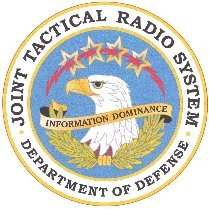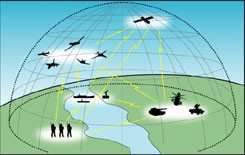Says It Can Be Done
 Lockheed Martin says it has
successfully completed a live fly demonstration of the Airborne,
Maritime and Fixed Station (AMF) component of the military's Joint
Tactical Radio Systems (JTRS) program. The demonstration featured
airborne, ground-based and simulated maritime units collaborating
in real time across an integrated airborne IP network to rapidly
find, identify and strike a time-sensitive target.
Lockheed Martin says it has
successfully completed a live fly demonstration of the Airborne,
Maritime and Fixed Station (AMF) component of the military's Joint
Tactical Radio Systems (JTRS) program. The demonstration featured
airborne, ground-based and simulated maritime units collaborating
in real time across an integrated airborne IP network to rapidly
find, identify and strike a time-sensitive target.
Lockheed Martin's AMF JTRS team funded and executed the
demonstration as a risk reduction effort to evaluate and improve
the technical maturity of the team's solution. The demonstration
follows a successful Preliminary Design Review, held in August,
which showcased numerous components of the team's AMF JTRS
solution. The latest demonstration brought those components
together in a live fly exercise, proving that the team's solution
is capable of creating an airborne IP network that can link
aircraft, ships and ground units in real time. The demo also
validated the Lockheed Martin team's approach to integrating AMF
JTRS radios into current Air Force and Navy platforms. The Lockheed
Martin team includes BAE SYSTEMS, General Dynamics, Raytheon and
Northrop Grumman.
 The AMF JTRS program will deliver a
suite of software defined, multi-function radios for use in all
three services of the Department of Defense, as well as potential
use in the Department of Homeland Security. Because the radio's
functions are defined in reusable software rather than hardware,
the systems will be capable of meeting the diverse multi-mission
roles facing the military and homeland security commanders in the
future. A single radio will be capable of operating on highly
secure, high performance military tactical networks in future
net-centric operations. In addition, AMF JTRS radios will
interoperate with legacy data and voice circuits used by the US,
allied or NATO military forces, as well as communicating with
civilian first-responder voice and data systems used in disaster
relief and other national emergencies.
The AMF JTRS program will deliver a
suite of software defined, multi-function radios for use in all
three services of the Department of Defense, as well as potential
use in the Department of Homeland Security. Because the radio's
functions are defined in reusable software rather than hardware,
the systems will be capable of meeting the diverse multi-mission
roles facing the military and homeland security commanders in the
future. A single radio will be capable of operating on highly
secure, high performance military tactical networks in future
net-centric operations. In addition, AMF JTRS radios will
interoperate with legacy data and voice circuits used by the US,
allied or NATO military forces, as well as communicating with
civilian first-responder voice and data systems used in disaster
relief and other national emergencies.
The demonstration, held the week of September 19-23, featured
two Saberliner jets serving as surrogates for an F-16 fighter and a
Predator unmanned aerial vehicle. A third node represented a Combat
Direction Center (CDC), a sea-based command center, and a fourth
node represented a Tactical Air Control Party utilizing an Enhanced
Position Location Reporting System (EPLRS) legacy radio. All four
nodes were able to exchange data and imagery using both prototype
AMF JTRS and legacy radios over a dynamic ad hoc airborne network,
demonstrating the power of net-centric communications enabled by
the Lockheed Martin team's AMF JTRS prototype.
"With this demonstration, our team is showing that not only can
we make the AMF JTRS system a reality, we can make it an enabler
for faster, more collaborative and more effective warfighting
operations," said John Mengucci, Lockheed Martin's vice president
and general manager for DoD Systems. "Our AMF JTRS technology is
mature, integrated and now proven in a live fly exercise. The
Lockheed Martin team is ready to deliver an AMF JTRS solution that
will revolutionize airborne and maritime communications."
The Lockheed Martin team has leveraged its extensive experience
in communications and networking technologies to develop
alternative solutions to many of the technical challenges faced by
the overall JTRS program. The team has developed, tested and
integrated waveforms that provide the capabilities of the JTRS
Wideband Networking Waveform (WNW), and continues to research and
develop proposed waveform enhancements to meet the needs of
fast-moving Navy and Air Force jets. The team has focused its
unmatched capabilities in airborne and maritime platforms and
communications systems to meet the unique integration challenge of
network-enabling the more than 160 varied platforms that will carry
AMF JTRS radios. This solution delivers on the promise of the AMF
JTRS program, a suite of hardware and software components all built
upon a common design to lower over-all cost across the military's
platform base.
 "In just 12 months, we've gone from
an initial architecture and system design to an integrated suite of
hardware and software that has proven its ability to enable
net-centric communications," said Dom Costa, Lockheed Martin's vice
president for AMF JTRS. "The entire team has made outstanding
progress throughout this competitive phase of the contract, and
we've combined advanced and proven technology from across the
industry to create a powerful, highly capable AMF JTRS solution
that will deliver on its promises. We're ready to make AMF JTRS a
reality for our nation's warfighters."
"In just 12 months, we've gone from
an initial architecture and system design to an integrated suite of
hardware and software that has proven its ability to enable
net-centric communications," said Dom Costa, Lockheed Martin's vice
president for AMF JTRS. "The entire team has made outstanding
progress throughout this competitive phase of the contract, and
we've combined advanced and proven technology from across the
industry to create a powerful, highly capable AMF JTRS solution
that will deliver on its promises. We're ready to make AMF JTRS a
reality for our nation's warfighters."
Lockheed Martin is one of two teams competing for the AMF JTRS
system design and development contract award, which is anticipated
in 2006.
FMI: www.lcmo.com
 Airborne-Flight Training 05.09.24: ERAU at AIAA, LIFT Diamond Buy, Epic A&P
Airborne-Flight Training 05.09.24: ERAU at AIAA, LIFT Diamond Buy, Epic A&P ANN's Daily Aero-Term (05.07.24): Hazardous Weather Information
ANN's Daily Aero-Term (05.07.24): Hazardous Weather Information Aero-News: Quote of the Day (05.07.24)
Aero-News: Quote of the Day (05.07.24) NTSB Final Report: Cessna 150
NTSB Final Report: Cessna 150 Aero-News: Quote of the Day (05.08.24)
Aero-News: Quote of the Day (05.08.24)





